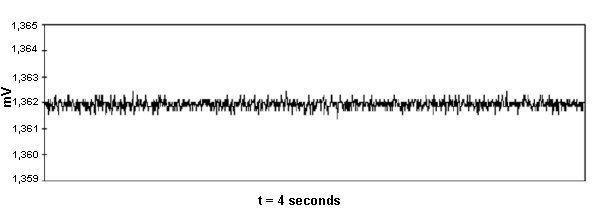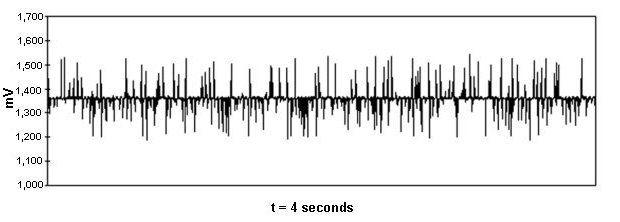
January 2000
by Thomas Lawson, Lawson Labs
 When you select an analog-to-digital
converter (ADC), the two most important numbers on the specification sheets
are speed and resolution. You might be tempted to choose
in favor of speed on the assumption that resolution can be recovered by
averaging a large amount of extra data. That is not necessarily a valid
approach.
When you select an analog-to-digital
converter (ADC), the two most important numbers on the specification sheets
are speed and resolution. You might be tempted to choose
in favor of speed on the assumption that resolution can be recovered by
averaging a large amount of extra data. That is not necessarily a valid
approach.
Averaged results can beguile and mislead. Of course, you should not use an ADC that is too slow for your application, but don't use one that is too fast either.
High-Speed Conversion
There are valid reasons for wanting extra throughput. Aliasing is a real and significant concern. Whenever AC components in your input signal approach or exceed half the sampling frequency, you must be careful. The higher data frequencies can appear as artifact at a much lower frequency.
Fear of aliasing, however, should not drive you to excessively high sampling rates. Ten years ago, it was not uncommon to run the fastest ADC you could buy at its full speed and still need more bandwidth. Now, ADCs are available that are more than fast enough for all but the most rarefied high-speed applications.
It is not as simple as "faster is better." Make a reasoned choice of what is fast enough. In most cases, it is entirely safe and satisfactory to roll off your input response at the maximum frequency of interest and then sample at eight times that frequency.
Problems With High Speed
You may specify a faster ADC than you need now on the theory that more speed may be desirable for a future, yet unspecified, project. That's fine as long as the ADC you use is stable and accurate enough for the current application.
Faster converters have some disadvantages that must be balanced against the lure of speed. Some of those drawbacks, such as lower accuracy, lower input impedance, or reduced input protection, can be seen in the specifications. Other disadvantages are less obvious.
Fast ADCs can generate huge data files in no time at all. Those large data files do more than fill up your disk drives. They also change the way you look at and think about your data. The more data you collect, the less likely you are to take a hard look at any one raw data file. In fact, you may completely stop looking at your raw data. That can be very dangerous.
If your data files are very large to begin with, you are less likely to include extra data for verification of the sensors, wiring, and timing of your system. You also are less likely to increase the scanning rate periodically to confirm the AC aspect of your results.
If you generate large data files, probably you have purchased or written postprocessing software to reduce your results to summarized form. You might be surprised at how many open sensors or misconfigured channels you could have without the evidence appearing in your summary data. Another penalty you can pay for faster ADC operation is higher power consumption and commensurate heat generation.
Last is the cost issue. Faster is pricier, and you may need a faster, more expensive computer to host the faster ADC. You can forget about salvaging that dusty old 386 computer for the data acquisition job. It all adds up, and with a speedier ADC, the cost of ownership accumulates faster, too.
Many discover the downside of speed after purchasing a fast ADC system. They often end up running their fast converters slowly and would have been better off getting a slower converter in the first place.
Trying to Recover Resolution
Can you recover resolution from the noise on that extremely fast converter by heavy averaging? Sometimes. You need to know when, because results obtained in this fashion can be just as deceptive as aliased results.
The crux of the matter is the nature of the noise. If the noise is symmetrically imposed on the signal, and the sum of data and noise is within the voltage and frequency range of the ADC, it should average out satisfactorily. Of course, this is true as long as the averaging period is appropriate for the periodicity of the noise.
Random noise on the power supplies and EMI can be averaged out only if that noise does not interfere with the integrity of the conversion process. However, in an actual ADC, it can be difficult to locate a point where periodic AC noise can be injected without generating DC errors in the averaged, digitized output. Do not assume that power supply noise or EMI can be averaged successfully. Filtering and shielding are the preferred approaches.
A more insidious problem is self-generated noise. It may appear to be indistinguishable from other types of noise, but actually it is the circuit interfering with its own operation. Averaging such noise yields only artifact. The processed signal will appear cleaner, but the pattern revealed may not bear any relationship to the input signal. For more information on self-generated noise, see the sidebar.
The issue of self-generated noise gains importance when you consider that it will be the predominant type of noise in a shielded ADC running on well-regulated power supplies and measuring clean input signals. All forms of noise get worse quickly as the conversion speed increases.
Faster amplifiers draw more power, pull sharper spikes on the power supply rails, run hotter, and have steeper, longer thermal tails. Also, radiated energy is higher at higher frequencies. All this adds into the error budget. If you need good accuracy at low speed, you would be well advised to use an acquisition system that is optimized for stability, not speed.
The Delta-Sigma Converter Solution
Delta-Sigma converters are increasingly used for lower-speed purposes. They are replacing integrating and voltage-to-frequency type converters as the preferred approach in many applications.
Delta-Sigma converters oversample and average digitally, so aren't they subject to the same problems? Yes, but much less so. In this converter, the digitization process is inside the feedback loop. Consequently, the converter works to servo its average digital output to match the analog output. By this process, the circuit can filter most of its self-generated noise. That solves some of the stickier problems associated with very-high-resolution ADCs.
Two pairs of figures compare a 16-bit successive-approximation ADC with a 24-bit Delta-Sigma ADC in the same application and illustrate approximately 1,000-to-1 improvement with the Delta-Sigma circuit. The Y-axis scale is in millivolts, and the time scale is 4 seconds.



Conclusion
Don't expect averaging or digital signal processing
to produce meaningful data beyond the monotonicity and linearity of any
type of ADC. The cleanliness of the processed result is not a measure
of its validity. When the input looks like unmowed grass, a shotgun blast,
or a Jackson Pollock painting, and the output is a crisp, thin line, ask
yourself if you are just looking at another form of the aliasing problem.
Self-Generated NoiseAbout the AuthorTo some extent, all ADCs interfere with their own operation. For example, in a successive-approximation converter, the decision is made sequentially to set or clear each bit, starting with the most significant. The comparator is the circuit element that makes the choice. The comparator's next decision may be affected by its last decision.
In an ideal circuit, the decisions would be totally separate. But in an actual circuit, the power supply, thermal, and stray coupling effects (EMI) allow earlier choices to influence subsequent ones.
Power Supply Contributions
You may have experienced a noisy power supply muddying your data, but it is easy to forget that circuits disturb their own supplies just by functioning. An amplifier slewing rapidly, temporarily saturated, or even just crossing zero volts can draw current spikes that cause power supply disruptions. These disruptions lead to unwanted coupling between circuit elements because of the inevitably imperfect power supply noise rejection.Thermal Contributions
Changes in power consumption lead to thermal changes that cause offset and gain errors that are transitory and cannot be calibrated away. Different components have different thermal masses and temperature coefficients. As a result, the thermal effects are spread over different time periods. Thermal errors are not simple exponential curves but complex interactions of multiple effects.Something as simple as a 5-kW resistor can contribute to thermal errors. With zero voltage across it, there is no current, no power, and no self-heating. At 5 V, it will have 5 mW of heating. It isn't much, but in the over-16-bit-resolution arena, resistor temperature coefficients become a major contributor of error.
EMI Contributions
Each loop that passes current is broadcasting energy. Each loop also is a receiving antenna. These effects generate undesirable coupling between circuits in an ADC. The result may appear to be random noise, but actually it is self-generated nonlinear interaction. When a circuit couples with another in an uncontrolled way, you can expect both DC and AC errors. These are elusive effects, and no amount of postprocessing will eliminate them.
Thomas Lawson founded Lawson Labs in 1981 and since then has designed more than 40 data acquisition products. Previously, Mr. Lawson was vice president of engineering at a medical electronics firm, a company with which he began his career 10 years earlier as a technical writer.
Published by EE-Evaluation
Engineering
All contents © 2000 Nelson Publishing Inc.